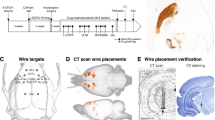Abstract
One of the main features of Parkinson’s disease is the neurodegeneration of the dopaminergic neurons of the substantia nigra pars compacta which causes a fall of the levels of dopamine in the striatum. This leads to alterations of the neural activity in all the structures of the loop circuit formed by the cortex, the basal ganglia, and thalamus. These alterations are believed to underlie the bradykinesia and hypokinesia observed in Parkinson’s disease. To study the correlation or the causality between circuitry neural activity and specific parkinsonian motor symptoms, the circuit can be interrogated by simultaneous extracellular recordings in diverse brain structures in behaving freely moving animals modeling Parkinson’s disease. Hereby, we describe the procedure to obtain the classical 6-hydroxydopamine Parkinson’s model combined with multi-area extracellular recordings in small behaving animals to access the activity of the parkinsonian cortico-basal ganglia-thalamo-cortical loop. Given that both the dopaminergic lesion caused by 6-hydroxydopamine, and the quality of the extracellular recordings have temporal dynamics of their own, the relative timing of both procedures is essential to obtain successful recording with high-quality signals.
Access this chapter
Tax calculation will be finalised at checkout
Purchases are for personal use only
Similar content being viewed by others
References
Hornykiewicz O (1966) Dopamine (3-hydroxytyramine) and brain function. Pharmacol Rev 18:925–964
Yung KKL, Bolam JP, Smith AD et al (1995) Immunocytochemical localization of D1 and D2 dopamine receptors in the basal ganglia of the rat: light and electron microscopy. Neuroscience 65:709–730
Surmeier DJ, Ding J, Day M et al (2007) D1 and D2 dopamine-receptor modulation of striatal glutamatergic signaling in striatal medium spiny neurons. Trends Neurosci 30:228–235
Albin RL, Young AB, Penney JB (1989) The functional anatomy of basal ganglia disorders. Trends Neurosci 12:366–375
Cui G, Jun SB, Jin X et al (2013) Concurrent activation of striatal direct and indirect pathways during action initiation. Nature 494:238–242
Halje P, Brys I, Mariman JJ et al (2019) Oscillations in cortico-basal ganglia circuits: implications for Parkinson’s disease and other neurologic and psychiatric conditions. J Neurophysiol 122:203–231
Buzsáki G, Anastassiou CA, Koch C (2012) The origin of extracellular fields and currents--EEG, ECoG, LFP and spikes. Nat Rev Neurosci 13:407–420
Schwarting RK, Huston JP (1996) The unilateral 6-hydroxydopamine lesion model in behavioral brain research. Analysis of functional deficits, recovery and treatments. Prog Neurobiol 50:275–331
Deumens R, Blokland A, Prickaerts J (2002) Modeling Parkinson’s disease in rats: an evaluation of 6-OHDA lesions of the nigrostriatal pathway. Exp Neurol 175:303–317
Costa RM, Lin S, Sotnikova TD et al (2006) Rapid alterations in corticostriatal ensemble coordination during acute dopamine-dependent motor dysfunction. Neuron 52:359–369
Fuentes R, Petterson P, Siesser WB et al (2009) Spinal cord stimulation restores locomotion in animal models of Parkinson’s disease. Science (80- ) 323:1578–1582
Moënne-Loccoz C, Astudillo-Valenzuela C, Skovgård K et al (2020) Cortico-striatal oscillations are correlated to motor activity levels in both physiological and Parkinsonian conditions. Front Syst Neurosci 14:56
Brys I, Nunes J, Fuentes R (2017) Motor deficits and beta oscillations are dissociable in an alpha-synuclein model of Parkinson’s disease. Eur J Neurosci 46:1906–1917
Brys I, Halje P, Scheffer-Teixeira R et al (2018) Neurophysiological effects in cortico-basal ganglia-thalamic circuits of antidyskinetic treatment with 5-HT1A receptor biased agonists. Exp Neurol 302:155–168
Avila I, Parr-Brownlie LC, Brazhnik E et al (2010) Beta frequency synchronization in basal ganglia output during rest and walk in a hemiparkinsonian rat. Exp Neurol 221:307–319
Delaville C, McCoy AJ, Gerber CM et al (2015) Subthalamic nucleus activity in the awake Hemiparkinsonian rat: relationships with motor and cognitive networks. J Neurosci 35:6918–6930
Yadav AP, Fuentes R, Zhang H et al (2014) Chronic spinal cord electrical stimulation protects against 6-hydroxydopamine lesions. Sci Rep 4:3839
Paxinos G, Watson C (2007) The rat brain in stereotaxic coordinates. Elsevier, San Diego
Brys I, Bobela W, Schneider BL et al (2016) Spinal cord stimulation improves forelimb use in an alpha-synuclein animal model of Parkinson’s disease. Int J Neurosci 7454:1–9
Author information
Authors and Affiliations
Corresponding author
Editor information
Editors and Affiliations
Rights and permissions
Copyright information
© 2023 The Author(s), under exclusive license to Springer Science+Business Media, LLC, part of Springer Nature
About this protocol
Cite this protocol
Garcia-Nuñez, X.P., Astudillo-Valenzuela, C., Fuentes-Flores, R. (2023). Multi-circuit Recording in Animal Models of Parkinson's Disease. In: Fuentealba-Evans, J.A., Henny, P. (eds) Dopaminergic System Function and Dysfunction: Experimental Approaches. Neuromethods, vol 193. Humana, New York, NY. https://doi.org/10.1007/978-1-0716-2799-0_12
Download citation
DOI: https://doi.org/10.1007/978-1-0716-2799-0_12
Published:
Publisher Name: Humana, New York, NY
Print ISBN: 978-1-0716-2798-3
Online ISBN: 978-1-0716-2799-0
eBook Packages: Springer Protocols




